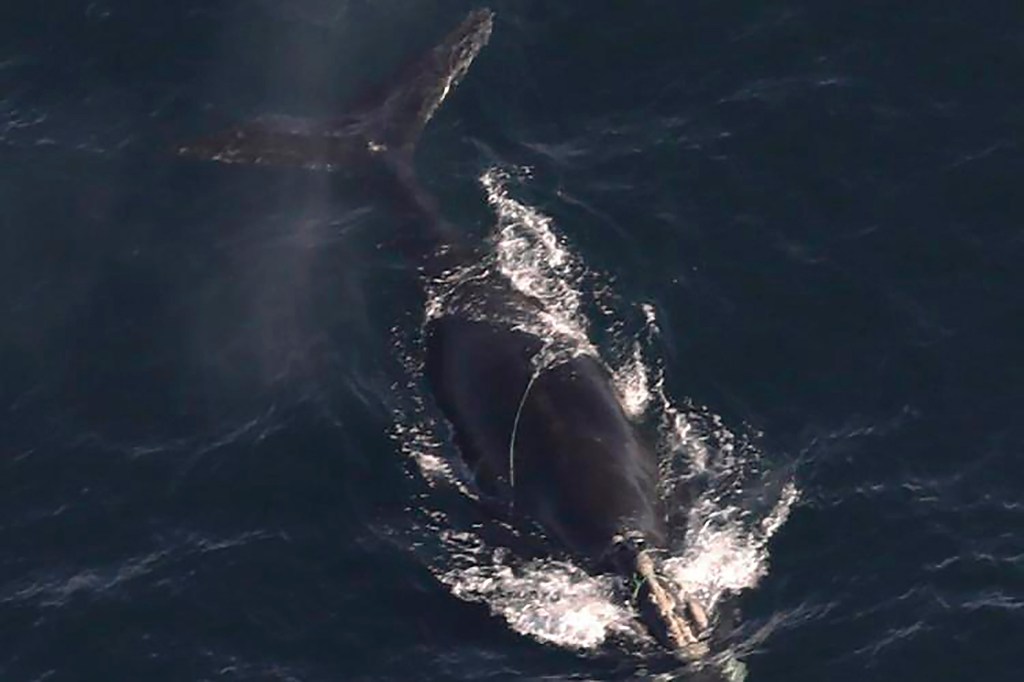
The number of North Atlantic right whales increased slightly last year, continuing a four-year trend of slow growth that indicates the critically endangered species is heading in the right direction, according to the North Atlantic Right Whale Consortium.
The estimated population increased from 376 in 2023 to 384 in 2024, based on a yearly update announced Tuesday by the scientists, regulators, and shipping and fishing representatives who make up the consortium.
The slight increase leaves consortium Chair Heather Pettis, who runs the right whale research program at New England Aquarium, cautiously optimistic even though the right whale remains the most endangered whale species on the planet.
“We still need strong protective measures for continued growth,” Pettis said Tuesday by email. “We don’t want to take our foot off the gas when it comes to management and conservation efforts.”
The fate of the right whale is intertwined, sometimes fatally, with that of Maine’s iconic $1.5 billion-a-year lobster industry. Entanglement in seabed-to-surface fishing ropes is one of the leading causes of death for these rare whales; fatal collisions with shipping vessels is the other.
Efforts to help the right whale rebound from a spate of fatal entanglements and vessel strikes that occurred in the U.S. and Canada in 2017 and 2019 have led to new fishing regulations and temporary lobstering bans that have squeezed fishermen on both sides of the border.
In 2021, officials at the National Oceanic and Atmospheric Administration ( NOAA), ordered the unprecedented closure of a 1,000-square-mile swath of ocean 3 miles off Maine’s coast to traditional lobster fishing for four months a year, starting that October.
Other whale protection measures, like requiring more traps attached to each surface-to-seabed buoy line, are on hold until at least 2028. A new Republican-led bill targeting the federal Marine Mammal Protection Act would extend that delay until 2035.
Patrice McCarron, executive director of the Maine Lobstermen’s Association, said the population update is encouraging.
“Even as federal regulators continue with plans to impose new restrictions on our industry, we remain steadfast in our commitment to protecting the right whale and the Maine lobster fishery. At the same time, we urge regulators to address other known threats,” McCarron said.
The Maine Department of Marine Resources, which regulates the in-state lobstering industry, did not want to comment on the population estimate and its regulatory implications, referring questions to NOAA.
The 2024 right whale population estimate is the product of a collaboration between NOAA and the New England Aquarium’s Anderson Cabot Center for Ocean Life and includes a margin of error of between nine and 10.
The population update is released in October, in coordination with the annual meeting of the North American Right Whale Consortium, which convenes in New Bedford, Massachusetts, this week for discussion of the latest research on whales and ropeless whale-safe fishing gear.
Many of the scientists and fishing industry representatives spent Monday behind closed doors discussing on-demand fishing gear and couldn’t be reached to discuss the estimated population increase.
Despite the overall estimated increase, 2024 was a difficult year for right whales that included five right whale deaths, 16 entanglements and eight vessel strikes, according to federal records. That included the first confirmed whale death caused by entanglement in Maine fishing ropes.
Scientists have logged no deaths so far in 2025 and only one new entanglement injury and one vessel strike, federal records show. There could still be additional deaths logged later this year, as 50% of last year’s entanglements occurred at the end of the year.
Eleven calves were born in the 2025 calving season, records show. Four of those were born to first-time mothers that were in good enough physical condition and had enough food to mate and carry the pregnancy to term, said Philip Hamilton, a scientist at the Anderson Cabot Center.
However, there remain about 41 breeding-age females that have yet to produce their first calf, Hamilton said. While delayed pregnancies are never a good thing for a population on the brink, Hamilton said it also means the population has tremendous potential for future growth.
“I really do believe there is a way for whales and the lobster fishery to coexist,” Hamilton said. “I think there is a way for both to win, to survive, but this is that awkward transition period where we try to figure out how that can happen. It’s going to take time and a lot of communication.”

We invite you to add your comments. We encourage a thoughtful exchange of ideas and information on this website. By joining the conversation, you are agreeing to our commenting policy and terms of use. More information is found on our FAQs. You can modify your screen name here.
Comments are managed by our staff during regular business hours Monday through Friday as well as limited hours on Saturday and Sunday. Comments held for moderation outside of those hours may take longer to approve.
Join the Conversation
Please sign into your CentralMaine.com account to participate in conversations below. If you do not have an account, you can register or subscribe. Questions? Please see our FAQs.